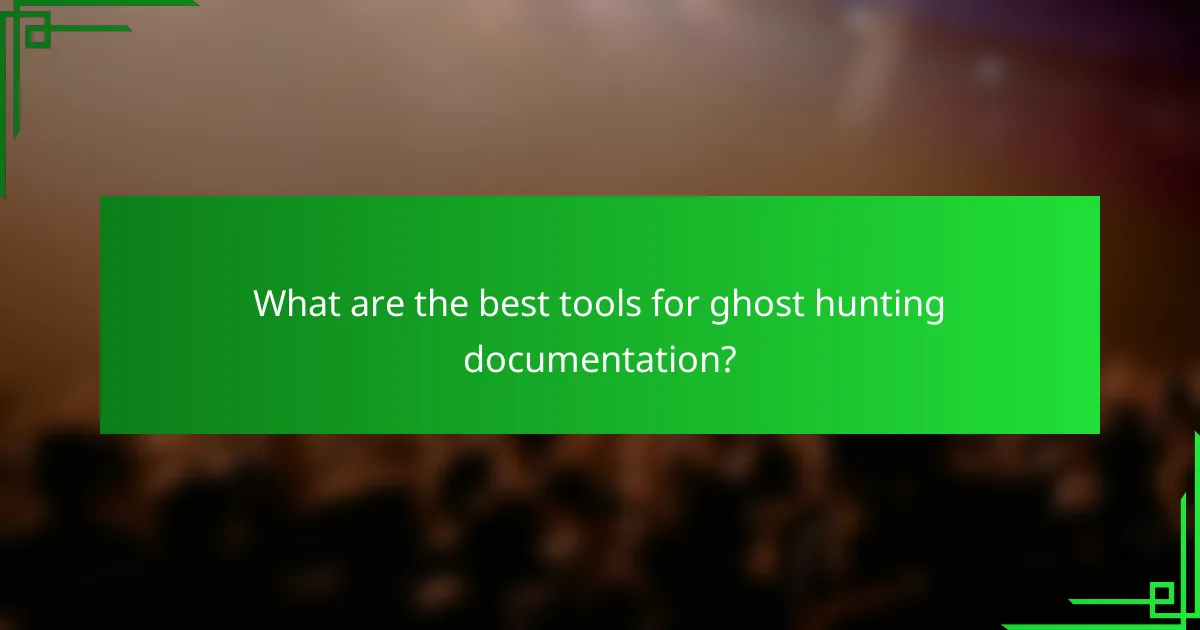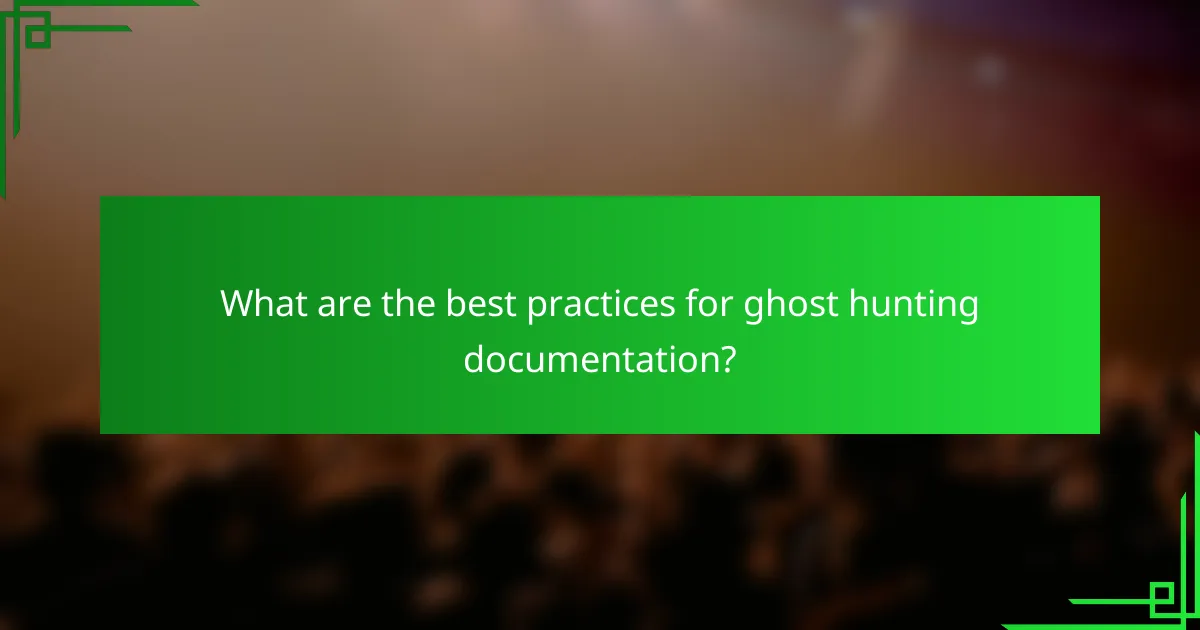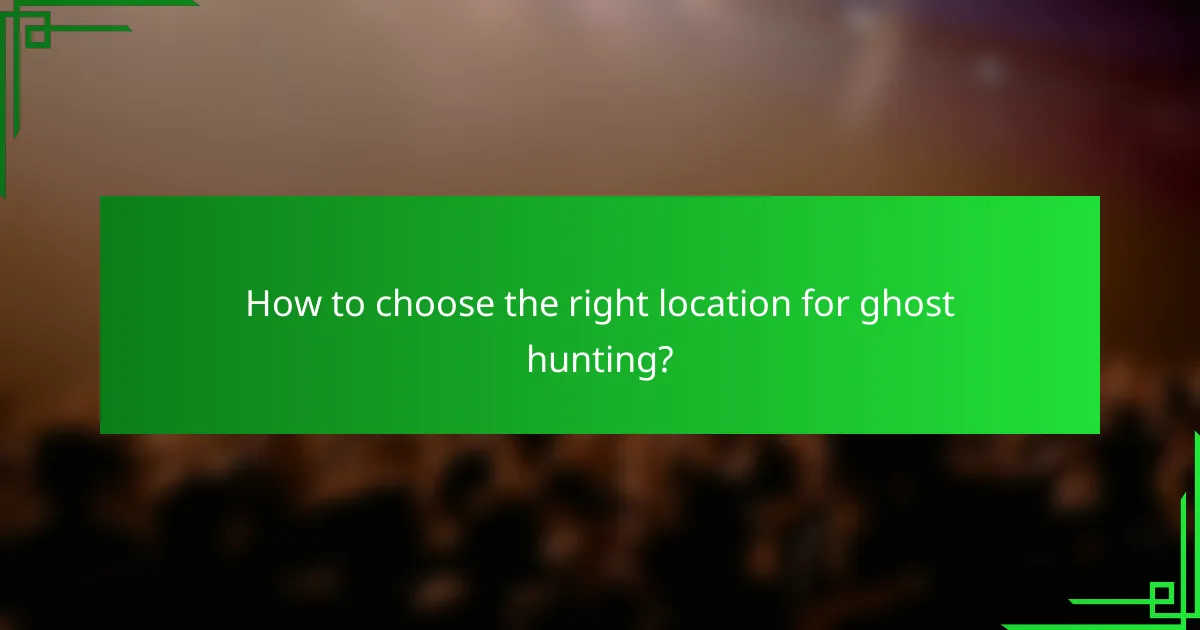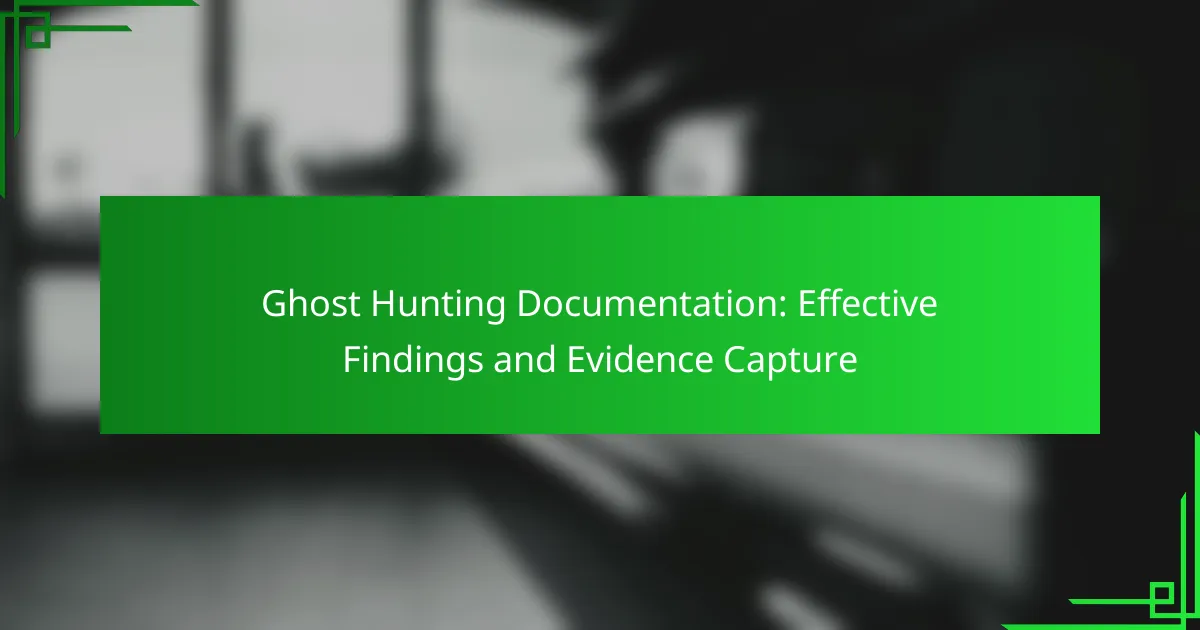Ghost hunting documentation is essential for capturing credible evidence and enhancing the overall investigation experience. By utilizing a variety of tools such as digital voice recorders and infrared cameras, along with maintaining detailed logs and conducting witness interviews, hunters can ensure their findings are both reliable and thorough. A systematic approach to recording observations not only supports the validity of the evidence but also enriches the understanding of paranormal activities.

What are the best tools for ghost hunting documentation?
The best tools for ghost hunting documentation include digital voice recorders, infrared cameras, EMF meters, spirit boxes, and thermal imaging devices. Each tool serves a unique purpose in capturing evidence and enhancing the ghost hunting experience.
Digital voice recorders
Digital voice recorders are essential for capturing audio evidence during ghost hunts. They can record sounds that may not be audible to the human ear, including potential spirit voices or EVPs (Electronic Voice Phenomena).
When using a digital voice recorder, choose one with high sensitivity and a good battery life. It’s advisable to conduct recordings in quiet locations to minimize background noise, and always review your recordings thoroughly for any unexplained sounds.
Infrared cameras
Infrared cameras are used to capture images in low-light conditions, making them ideal for ghost hunting. These cameras can detect temperature variations and visual anomalies that may indicate paranormal activity.
When selecting an infrared camera, look for one with a high resolution and good low-light performance. Ensure you understand how to interpret the images, as not all anomalies are necessarily paranormal; some may have natural explanations.
EMF meters
EMF meters measure electromagnetic fields, which some believe can indicate the presence of spirits. High readings in areas with no electrical sources may suggest paranormal activity.
When using an EMF meter, familiarize yourself with normal background levels to distinguish between natural and potentially paranormal readings. Avoid areas with known electrical interference, as this can lead to false positives.
Spirit boxes
Spirit boxes are devices that scan radio frequencies to facilitate communication with spirits. They create white noise, which some believe spirits can manipulate to form words or phrases.
To effectively use a spirit box, ask clear, direct questions and listen attentively for responses. It’s helpful to record the session for later analysis, as responses may be subtle and easily missed in real-time.
Thermal imaging devices
Thermal imaging devices detect heat signatures, allowing users to visualize temperature differences in their environment. This can reveal cold spots or unusual heat patterns that may indicate paranormal presence.
When using thermal imaging, ensure the device is calibrated correctly and understand that temperature fluctuations can occur naturally. Look for consistent patterns rather than isolated readings to assess potential paranormal activity accurately.

How to effectively capture evidence during ghost hunts?
To effectively capture evidence during ghost hunts, utilize a combination of recording devices, document environmental conditions, maintain a detailed log, and conduct interviews with witnesses. This multi-faceted approach enhances the credibility and depth of your findings.
Use multiple recording devices
Using multiple recording devices increases the likelihood of capturing credible evidence. Consider employing audio recorders, video cameras, and thermal imaging devices simultaneously to gather diverse data types. Each device can reveal different aspects of paranormal activity, such as sounds, visual anomalies, or temperature fluctuations.
When setting up your devices, ensure they are placed strategically in areas of interest. For instance, audio recorders should be positioned where unexplained sounds are reported, while cameras can focus on locations with high activity. Regularly check battery levels and storage capacity to avoid interruptions.
Document environmental conditions
Documenting environmental conditions is crucial for understanding the context of your findings. Factors like temperature, humidity, and electromagnetic fields can influence both the experience and the evidence collected. Use a digital thermometer, hygrometer, and EMF meter to record these variables during your investigation.
Keep a record of any fluctuations in these conditions, as they may correlate with reported paranormal events. For example, a sudden drop in temperature could indicate the presence of a spirit, while spikes in electromagnetic fields might suggest energy disturbances.
Maintain a detailed log
Maintaining a detailed log of your ghost hunting activities helps to organize your findings and provides a timeline of events. Document the date, time, location, environmental conditions, and any notable occurrences or evidence captured. This log serves as a reference for analyzing patterns and corroborating witness accounts.
Include specific details about each recording session, such as device settings and any interactions with the environment. A well-maintained log can enhance the credibility of your evidence and assist in future investigations.
Conduct interviews with witnesses
Conducting interviews with witnesses is essential for gathering qualitative evidence. Speak with individuals who have experienced paranormal activity in the area to gain insights into their encounters. Their descriptions can provide context and help identify patterns that may not be immediately apparent through recordings alone.
Prepare open-ended questions to encourage detailed responses, and consider recording these interviews for accuracy. This firsthand information can complement your physical evidence and strengthen your overall findings.

What are the best practices for ghost hunting documentation?
Effective ghost hunting documentation involves systematic recording of evidence and observations to support findings. Following best practices ensures that the data collected is reliable and can be analyzed accurately.
Establish a clear protocol
Creating a clear protocol is essential for ghost hunting documentation. This includes defining specific procedures for data collection, observation, and evidence recording. A well-structured protocol helps maintain consistency across different investigations.
For example, outline the steps for setting up equipment, conducting interviews, and documenting findings. This ensures that all team members understand their roles and responsibilities, reducing the risk of missing critical information.
Ensure proper equipment calibration
Proper calibration of ghost hunting equipment is crucial for accurate readings. Before each investigation, check that devices such as EMF meters, digital voice recorders, and thermal cameras are functioning correctly. Calibration should be done according to the manufacturer’s instructions.
Regular maintenance and testing of equipment can prevent false positives and ensure that the data collected is reliable. For instance, using a known EMF source can help verify that the meter is responding accurately before starting the investigation.
Review and analyze findings collaboratively
Collaborative review of findings enhances the quality of ghost hunting documentation. After an investigation, gather the team to discuss observations and evidence collected. This collective analysis can reveal insights that may have been overlooked by individual members.
Utilizing tools like shared digital platforms for documentation allows for easy access and organization of evidence. Consider creating a checklist for key points to discuss, such as the relevance of specific findings and potential explanations for anomalies observed during the investigation.

What should be included in a ghost hunting report?
A ghost hunting report should include essential details that document the investigation, findings, and evidence. Key elements include location history, equipment used, evidence collected, and witness testimonies to provide a comprehensive overview of the experience.
Location details and history
Provide a thorough description of the location where the ghost hunt took place. Include information such as the address, type of building, and any relevant historical context that may contribute to the paranormal activity, such as past events or notable figures associated with the site.
Consider including maps or photographs that illustrate the layout and significant areas of interest. This helps to contextualize the findings and allows readers to visualize the environment in which the investigation occurred.
Equipment used and settings
List all equipment utilized during the ghost hunt, including cameras, audio recorders, EMF detectors, and thermal imaging devices. Specify the model and settings used for each piece of equipment, as this can affect the quality and reliability of the evidence collected.
Document any calibration or adjustments made prior to the investigation. This transparency helps validate the findings and allows for replication of the methods in future investigations.
Evidence collected and analysis
Detail the evidence gathered during the ghost hunt, such as photographs, audio recordings, and EMF readings. Describe each piece of evidence, including the conditions under which it was collected and any anomalies observed.
Provide an analysis of the evidence, discussing its significance and any potential explanations. This could include comparisons to known phenomena or other documented cases, helping to establish credibility and context for the findings.
Witness testimonies
Include statements from individuals who experienced the paranormal activity firsthand. These testimonies can provide valuable insights and support the evidence collected during the investigation.
Ensure that testimonies are documented clearly, noting the witness’s background and any relevant experiences that may influence their perspective. This adds depth to the report and helps to corroborate the findings with personal accounts.

How to choose the right location for ghost hunting?
Selecting the right location for ghost hunting is crucial for capturing compelling evidence. Ideal sites often have a history of paranormal activity, are accessible, and provide a safe environment for exploration.
Consider historical significance
Locations with a rich history often have stories of hauntings or unexplained events. Researching the background of a site can reveal its potential for ghostly encounters. Look for places like old hospitals, abandoned buildings, or battlefields that have documented paranormal claims.
Evaluate accessibility and safety
Accessibility is key when choosing a ghost hunting location. Ensure that the site is reachable, especially during nighttime investigations. Additionally, prioritize safety by avoiding locations that pose physical hazards or are in unsafe neighborhoods.
Assess environmental conditions
Environmental factors can significantly impact ghost hunting experiences. Consider locations that are quiet and away from urban noise, as this can enhance your ability to hear unusual sounds. Weather conditions also matter; clear nights are often preferred for visibility and comfort.
Check for legal permissions
Before conducting a ghost hunt, verify that you have the necessary permissions to access the location. Some sites may require permits or have restrictions on nighttime visits. Always respect private property and local regulations to avoid legal issues.
